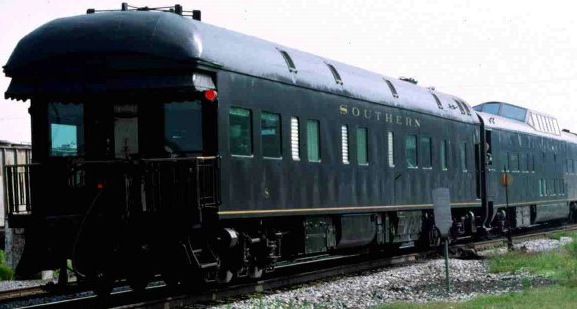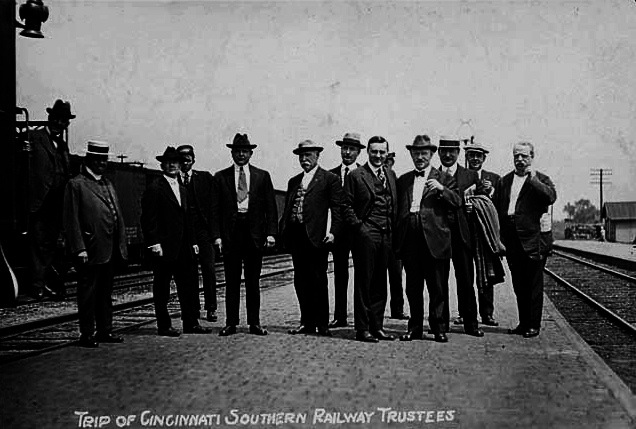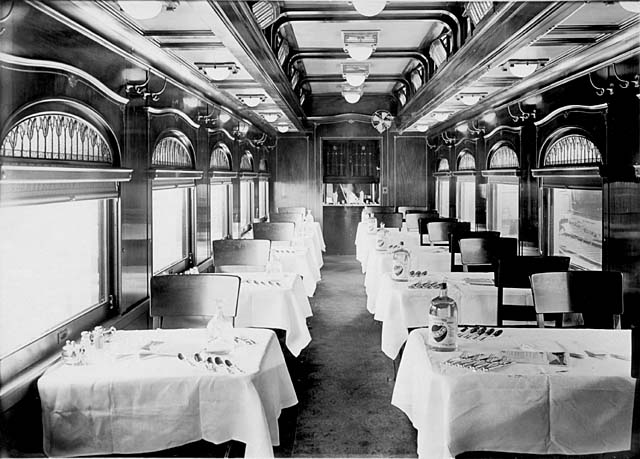History
Home > History
Echoes of the Rails
Exploring Ferguson's Train-Tracked History

Our Story
From 1910 to 1955, Ferguson thrived as a railroad town, shaped by the rails laid out by district executive Edward Ferguson. The railroad not only built the school but also ensured its excellence for 45 years, catering to employees’ families and future workers. Annual Senior Trips to Florida were a highlight, courtesy of the railroad’s own passenger cars. Despite its closure, Ferguson’s tradition continued by bus. The railroad’s benefits extended beyond wages, offering healthcare, holiday gifts, vacations, free travel, and retirement pensions to employees’ families.
The Engine Shop
This is the engine shop, seen on the far left in the photo. It’s where eight full-sized engines are serviced. A crew of six works on each engine, ensuring they’re in top condition. The shop operates six days a week, bustling with activity. Any leaking seals must be promptly fixed to avoid setbacks. Typically, reconditioning a steam engine takes two to three weeks.


The Ferguson Shops
The Ferguson Shops stood as the heartbeat of the Southern Railroad, welcoming every engine for servicing every 100,000 miles, or more frequently for repairs or unusual wear issues. As the linchpin of the entire operation, Ferguson saw frequent visits from trustees and officials. These unannounced visits allowed them to assess the shop’s efficiency firsthand. Despite their corporate attire, these visitors were well-versed in railroading and spent whole days meticulously inspecting the shops, asking pertinent questions, and ensuring everything ran smoothly.
Railroad dining cars
A railroad dining car was a rolling version of a very high class restaurant. But it had its own ways of operating. The menu was limited to only a few items. You could order a meat, fish or chicken entree and two sides from a list of four or six. You had a choice of three salads and three desserts. The beverage list would include coffee, milk, tea, a white or red wine, apple or tomato juice. However, within this limited menu, the quality would be outstanding. You could not order a better meal in the finest restaurants in Chicago, New York or Atlanta. The meal was included in your ticket. An attendant would come to your seat and offer you a choice of seating times. Breakfast was served from 6 to 9, lunch from 11:30 to 1:30, and dinner from 4:30 to 7:30. Seatings were every half hour. Then the attendant would hand you a menu and take your order. So when you arrived at the car at the chosen time, you were immediately seated and the food was ready. Dishes, bowls, cups and glasses were specially made to hold foods and drinks on the moving trains.

Ties Magazine
This Ties Magazine cover commemorates the debut of the revolutionary diesel-electric locomotive on its inaugural journey with the Southern Railroad. Notably, this locomotive features a unique four-unit design, with the front unit housing the controls and the other three serving as “helper” units. The photograph captures the tunnel and Cumberland River Bridge at Burnside before the formation of the lake. Unbeknownst at the time, this marked the end of the Ferguson Yard. As officials tested the new engines along the route, they discovered significantly reduced servicing requirements. These diesel-electric locomotives could travel longer distances without stops, leading to substantial cost savings. After two years of deliberation, it was decided that the Ferguson Yard would be phased out. The fireman seen leaning out of the cab is Charles F. Denny of Ferguson, whose father served as Chief Dispatcher on the Southern Railroad’s Somerset Section. Tragically, Charles enlisted in the Marines shortly after this photo was taken and lost his life in action after one year of service. Ties Magazine was distributed monthly, free of charge, to all employees of the Southern Railroad.
Nancy Atchley's Ferguson School Archives
The Ferguson School Archive
The Ferguson School Archive, a cherished repository of memories, was born from the dedication of Nancy Atchley, a proud member of Ferguson School’s last senior class. In 2008, she ignited a local firestorm on Topix.com, sparking thousands of nostalgic posts and requests for a dedicated platform to preserve our shared history. Today, we honor Nancy’s vision by preserving these precious memories, recognizing that this archive belongs not to any one individual, but to the collective soul of Ferguson. Join us in celebrating our past and contributing to our ever-growing archive of stories, photos, and clippings. Together, we ensure that the legacy of our beloved Ferguson lives on for generations to come.
Students
Explore a visual journey through the vibrant history of Ferguson School with our collection of student images.
Sports
Relive the excitement and camaraderie of Ferguson School's athletic achievements through our sports archive.
Staff
Meet the dedicated men and women who helped to shape the educational experience and legacy at Ferguson School.
Community
View historical memories of the past that unite the Ferguson community, for future generations.

Nancy Atchley's
Ferguson School Archive
A tribute to FergusonSchool.com
Addendum from the original FergusonSchool.com:
“Nancy Atchley was a member of the last senior class, the 1967-68 group. She was born and raised in Ferguson and attended school there from first through 12th grade. She was a cheerleader, basketball scorekeeper, and member of the newspaper and yearbook staffs. She left Ferguson in 1968 and attended Michigan State University and the University of California, majoring in Journalism. As the wife of thoroughbred jockey Glen Brogan, she spent three decades in the racing industry, breaking and training horses and living in Michigan, California, Pennsylvania, Florida and Louisiana. She has four children. Nancy returned home to Somerset when her mother became ill. She has now permanently relocated there.
[The original] website evolved from simple beginnings. In Sepember of 2008, Nancy posted a thread on Topix, a local internet message board. She asked if anyone remembered going to school at Ferguson. Expecting perhaps a dozen responses, she watched with amazement as the thread grew to more than six thousand posts. Over a hundred Ferguson alumni and residents checked in once a day to read the stories and look at the photographs and old newspaper clippings being submitted. Requests began coming in for her to create a separate website where photos, clippings and stories could be more appropriately showcased. Nancy organized a group willing to help and began assembling the site. She runs it out of her home and devotes about an hour a day to her duties as the message board moderator. These pages were created with Dreamweaver software.”

